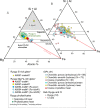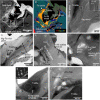Microstructural and chemical features of impact melts on Ryugu particle surfaces: Records of interplanetary dust hit on asteroid Ryugu
- PMID: 38241366
- PMCID: PMC10798560
- DOI: 10.1126/sciadv.adi7203
Microstructural and chemical features of impact melts on Ryugu particle surfaces: Records of interplanetary dust hit on asteroid Ryugu
Abstract
The Hayabusa2 spacecraft delivered samples of the carbonaceous asteroid Ryugu to Earth. Some of the sample particles show evidence of micrometeoroid impacts, which occurred on the asteroid surface. Among those, particles A0067 and A0094 have flat surfaces on which a large number of microcraters and impact melt splashes are observed. Two impact melt splashes and one microcrater were analyzed to unveil the nature of the objects that impacted the asteroid surface. The melt splashes consist mainly of Mg-Fe-rich glassy silicates and Fe-Ni sulfides. The microcrater trapped an impact melt consisting mainly of Mg-Fe-rich glassy silicate, Fe-Ni sulfides, and minor silica-rich glass. These impact melts show a single compositional trend indicating mixing of Ryugu surface materials and impactors having chondritic chemical compositions. The relict impactor in one of the melt splashes shows mineralogical similarity with anhydrous chondritic interplanetary dust particles having a probable cometary origin. The chondritic micrometeoroids probably impacted the Ryugu surface during its residence in a near-Earth orbit.
Figures









Similar articles
-
Noble gases and nitrogen in samples of asteroid Ryugu record its volatile sources and recent surface evolution.Science. 2023 Feb 24;379(6634):eabo0431. doi: 10.1126/science.abo0431. Epub 2023 Feb 24. Science. 2023. PMID: 36264828
-
Formation and evolution of carbonaceous asteroid Ryugu: Direct evidence from returned samples.Science. 2023 Feb 24;379(6634):eabn8671. doi: 10.1126/science.abn8671. Epub 2023 Feb 24. Science. 2023. PMID: 36137011
-
The Albedo of Ryugu: Evidence for a High Organic Abundance, as Inferred from the Hayabusa2 Touchdown Maneuver.Astrobiology. 2020 Jul;20(7):916-921. doi: 10.1089/ast.2019.2198. Epub 2020 Jun 15. Astrobiology. 2020. PMID: 32543220 Free PMC article.
-
Organic Matter in the Asteroid Ryugu: What We Know So Far.Life (Basel). 2023 Jun 26;13(7):1448. doi: 10.3390/life13071448. Life (Basel). 2023. PMID: 37511823 Free PMC article. Review.
-
Cometary dust: the diversity of primitive refractory grains.Philos Trans A Math Phys Eng Sci. 2017 Jul 13;375(2097):20160260. doi: 10.1098/rsta.2016.0260. Philos Trans A Math Phys Eng Sci. 2017. PMID: 28554979 Free PMC article. Review.
Cited by
-
Sulfide minerals bear witness to impacts across the solar system.Nat Commun. 2025 Jul 1;16(1):5975. doi: 10.1038/s41467-025-61201-6. Nat Commun. 2025. PMID: 40592914 Free PMC article.
-
Nonmagnetic framboid and associated iron nanoparticles with a space-weathered feature from asteroid Ryugu.Nat Commun. 2024 Apr 29;15(1):3493. doi: 10.1038/s41467-024-47798-0. Nat Commun. 2024. PMID: 38684653 Free PMC article.
References
-
- Keller L. P., McKay D. S., Discovery of vapor deposits in the lunar regolith. Science 261, 1305–1307 (1993). - PubMed
-
- Noguchi T., Nakamura T., Kimura M., Zokensky M. E., Tanaka M., Hashimoto H., Konno M., Nakato A., Ogami T., Fujimura A., Abe M., Yada T., Mukai T., Ueno M., Okada T., Shirai K., Ishibashi Y., Okazaki R., Incipient space weathering observed on the surface of Itokawa dust particles. Science 333, 1121–1125 (2011). - PubMed
-
- Noguchi T., Kimura M., Hashimoto T., Konno M., Nakamura T., Zolensky M. E., Okazaki R., Tanaka M., Tsuchiyama A., Nakato A., Ogami T., Ishida H., Sagae R., Tsujimori S., Matsumoto T., Matsuno J., Fujiwara A., Abe M., Yada T., Mukai T., Ueno M., Okada T., Shirai K., Ishibashi Y., Space weathered rims found on the surfaces of the Itokawa dust particles. Meteorit. Planet. Sci. 49, 188–214 (2014).
-
- Noble S. K., Keller L. P., Pieters C. M., Evidence of space weathering in regolith breccias I: Lunar regolith breccias. Meteorit. Planet. Sci. 40, 397–408 (2005).
-
- Noble S. K., Keller L. P., Pieters C. M., Evidence of space weathering in regolith breccias II: Asteroidal regolith breccias. Meteorit. Planet. Sci. 45, 2007–2015 (2011).
LinkOut - more resources
Full Text Sources

